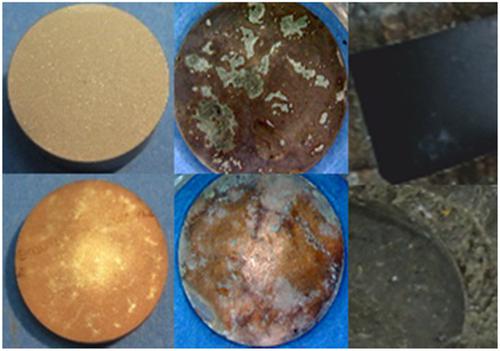当前位置:
X-MOL 学术
›
Mater. Corros.
›
论文详情
Our official English website, www.x-mol.net, welcomes your feedback! (Note: you will need to create a separate account there.)
Further results on the in situ anaerobic corrosion of carbon steel and copper in compacted bentonite exposed to natural Opalinus Clay porewater containing native microbial populations
Materials and Corrosion ( IF 1.8 ) Pub Date : 2020-09-29 , DOI: 10.1002/maco.202011785 Bharti Reddy 1 , Cristiano Padovani 1 , Nick R. Smart 1 , Andrew P. Rance 1 , Angus Cook 1 , Antoni Milodowski 2 , Lorraine Field 2 , Simon Kemp 2 , Nikitas Diomidis 3
Materials and Corrosion ( IF 1.8 ) Pub Date : 2020-09-29 , DOI: 10.1002/maco.202011785 Bharti Reddy 1 , Cristiano Padovani 1 , Nick R. Smart 1 , Andrew P. Rance 1 , Angus Cook 1 , Antoni Milodowski 2 , Lorraine Field 2 , Simon Kemp 2 , Nikitas Diomidis 3
Affiliation

|
Since 2012, a long‐term in situ corrosion experiment (IC‐A) is being conducted in the Mont Terri Underground Research Laboratory in Switzerland to investigate the corrosion behaviour of candidate canister materials in conditions representative of the Swiss concept for the disposal of high‐level waste and spent nuclear fuel. To date, carbon steel and various types of copper coatings have been retrieved after different exposure periods of up to 3 years, and characterised to establish the composition of the corrosion product, the morphology of the corroded surface, the nature of the interaction between the metal and the surrounding bentonite, and the microbial populations in the bentonite and surrounding porewater. For carbon steel specimens, a complex corrosion product was identified, consisting predominantly of magnetite. Much less alteration on either the metal or the bentonite was observed in the case of copper samples. Low average anaerobic corrosion rates were measured for carbon steel and a very modest amount of alteration was identified on copper. The density and the initial form of the bentonite had a small influence on the rate of corrosion, across all materials. This paper summarises the results of the experimental programme obtained to date and discusses the relationship observed between exposure time and the evolution of the metal–bentonite interface for both carbon steel and copper.
中文翻译:

暴露于含有天然微生物种群的天然蛋白石粘土孔隙水中的压实膨润土中碳钢和铜的原位厌氧腐蚀的进一步结果
自2012年以来,瑞士的Mont Terri地下研究实验室正在进行长期原位腐蚀实验(IC‐A),以研究代表瑞士概念的条件下处理高碳钢的候选罐材料的腐蚀行为。废物和废核燃料的水平。迄今为止,碳钢和各种类型的铜涂层在经过长达3年的不同暴露时间后已被回收,其特征在于确定腐蚀产物的成分,腐蚀表面的形态,金属之间相互作用的性质。以及周围的膨润土,以及膨润土和周围孔隙水中的微生物种群。对于碳钢试样,鉴定出一种复杂的腐蚀产物,主要由磁铁矿组成。在铜样品的情况下,观察到金属或膨润土的变化少得多。碳钢的平均厌氧腐蚀速率很低,而铜的蚀变非常小。膨润土的密度和初始形式对所有材料的腐蚀速率影响很小。本文总结了迄今为止获得的实验程序的结果,并讨论了碳钢和铜的暴露时间与金属-膨润土界面演变之间的关系。膨润土的密度和初始形式对所有材料的腐蚀速率影响很小。本文总结了迄今为止获得的实验程序的结果,并讨论了碳钢和铜的暴露时间与金属-膨润土界面演变之间的关系。膨润土的密度和初始形式对所有材料的腐蚀速率影响很小。本文总结了迄今为止获得的实验程序的结果,并讨论了碳钢和铜的暴露时间与金属-膨润土界面演变之间的关系。
更新日期:2020-09-29
中文翻译:

暴露于含有天然微生物种群的天然蛋白石粘土孔隙水中的压实膨润土中碳钢和铜的原位厌氧腐蚀的进一步结果
自2012年以来,瑞士的Mont Terri地下研究实验室正在进行长期原位腐蚀实验(IC‐A),以研究代表瑞士概念的条件下处理高碳钢的候选罐材料的腐蚀行为。废物和废核燃料的水平。迄今为止,碳钢和各种类型的铜涂层在经过长达3年的不同暴露时间后已被回收,其特征在于确定腐蚀产物的成分,腐蚀表面的形态,金属之间相互作用的性质。以及周围的膨润土,以及膨润土和周围孔隙水中的微生物种群。对于碳钢试样,鉴定出一种复杂的腐蚀产物,主要由磁铁矿组成。在铜样品的情况下,观察到金属或膨润土的变化少得多。碳钢的平均厌氧腐蚀速率很低,而铜的蚀变非常小。膨润土的密度和初始形式对所有材料的腐蚀速率影响很小。本文总结了迄今为止获得的实验程序的结果,并讨论了碳钢和铜的暴露时间与金属-膨润土界面演变之间的关系。膨润土的密度和初始形式对所有材料的腐蚀速率影响很小。本文总结了迄今为止获得的实验程序的结果,并讨论了碳钢和铜的暴露时间与金属-膨润土界面演变之间的关系。膨润土的密度和初始形式对所有材料的腐蚀速率影响很小。本文总结了迄今为止获得的实验程序的结果,并讨论了碳钢和铜的暴露时间与金属-膨润土界面演变之间的关系。

























 京公网安备 11010802027423号
京公网安备 11010802027423号